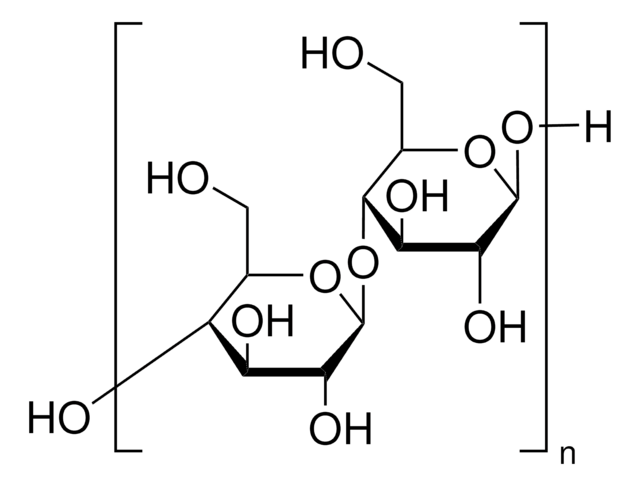22197
Cellulose
DS-0, powder, suitable for thin layer chromatography (TLC)
Synonym(s):
Cellulose powder, Cotton linters
Sign Into View Organizational & Contract Pricing
All Photos(1)
About This Item
Recommended Products
Quality Level
form
powder
technique(s)
thin layer chromatography (TLC): suitable
ign. residue
≤0.1%
loss
≤5% loss on drying
InChI
1S/C12H22O11/c13-1-3-5(15)6(16)9(19)12(22-3)23-10-4(2-14)21-11(20)8(18)7(10)17/h3-20H,1-2H2/t3?,4?,5?,6?,7?,8?,9?,10-,11?,12+/m1/s1
InChI key
GUBGYTABKSRVRQ-WFVLMXAXSA-N
Looking for similar products? Visit Product Comparison Guide
Related Categories
General description
Cellulose, a homopolymer consisting of glucose units joined by β-1,4 bonds. These are strongly attached through inter and intramolecular hydrogen bonds and vander Waals forces resulting in microfibrils which together form fibers. They are arranged in parallel reducing ends of adjacent glucan chains. Cellulose is widely used as sorbent in TLC.
Application
Cellulose was used to measure the cyrstallinity index using X-ray diffraction (XRD) patterns and solid-state 13C nuclear magnetic resonance (NMR) spectra.
microcrystalline cellulose for all types of separation chromatography and thin layer electrophoresis
High purity cellulose powders for partition chromatography.
Storage Class
11 - Combustible Solids
wgk_germany
WGK 1
flash_point_f
Not applicable
flash_point_c
Not applicable
ppe
Eyeshields, Gloves, type N95 (US)
Choose from one of the most recent versions:
Already Own This Product?
Find documentation for the products that you have recently purchased in the Document Library.
Customers Also Viewed
Sunkyu Park et al.
Biotechnology for biofuels, 3, 10-10 (2010-05-26)
Although measurements of crystallinity index (CI) have a long history, it has been found that CI varies significantly depending on the choice of measurement method. In this study, four different techniques incorporating X-ray diffraction and solid-state 13C nuclear magnetic resonance
S B Leschine
Annual review of microbiology, 49, 399-426 (1995-01-01)
In anaerobic environments rich in decaying plant material, the decomposition of cellulose is brought about by complex communities of interacting microorganisms. Because the substrate, cellulose, is insoluble, bacterial and fungal degradation occurs exocellularly, either in association with the outer cell
Jadranka Odović et al.
Iranian journal of pharmaceutical research : IJPR, 11(3), 763-770 (2012-07-01)
In this assay, the evaluation of lipophilicity of four ACE-inhibitors and hydrochlorothiazide (HCTZ) with RP-TLC on cellulose layers was described using three binary solvent systems. The selected ACE inhibitors had sufficiently different structures which can indicate the method suitability for
Ginger Brininstool et al.
BMC plant biology, 8, 58-58 (2008-05-20)
The Arabidopsis thaliana CONSTITUTIVE EXPRESSOR OF PATHOGENESIS-RELATED GENES5 (CPR5) gene has been previously implicated in disease resistance, cell proliferation, cell death, and sugar sensing, and encodes a putative membrane protein of unknown biochemical function. Trichome development is also affected in
Tomoko Maehara et al.
Fungal biology, 117(3), 220-226 (2013-03-30)
Ethanol production by Flammulina velutipes from high substrate concentrations was evaluated. F. velutipes produces approximately 40-60 g l(-1) ethanol from 15% (w/v) D-glucose, D-fructose, D-mannose, sucrose, maltose, and cellobiose, with the highest conversion rate of 83% observed using cellobiose as
Our team of scientists has experience in all areas of research including Life Science, Material Science, Chemical Synthesis, Chromatography, Analytical and many others.
Contact Technical Service
